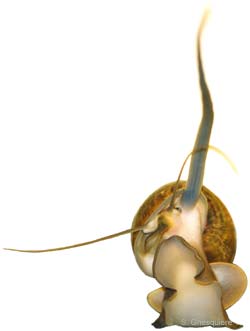
Pomacea haustrum,one of the larger apple snails, with extended siphon.
| Respiratory system |
|
Overview 3D anatomy Digestion Senses Nerves Respiration Circulation Reproduction Other Shell |
 Pomacea haustrum,one of the larger apple snails, with extended siphon. |
The respiratory system of the apple snail is highly adapted to tropical waters,
which once in a while dry up. This change in water availability is reflected
in the apple snails respiration system: a combination of both a gill
and a lung.
The arise of the lung in apple snail can be explained by
the following conditions:
Low oxygen levels:
The oxygen (O2) levels in tropical pools can
become very low due to the combination of high temperatures and a lot of rotting
organic waste. Aerial respiration is a efficient way to overcome this lack of
oxygen in the water and is not only used by snails, but also certain fishes
have developed an organ to derive oxygen from air (for example labyrinth fishes
like Betta splendens and others).
Periods of drought:
Many pools and small rivers in tropical regions dry up during periods of drought.
In these periods apple snails aestivate buried in the mud and having only a
gill would drastically decrease the chance to survive in such condition.
Availability of food:
Having a lung increases the action radius of the snail. On other word: the snails
can leave the water for short periods to gather food above the water surface.
Although apple snails do have developed a lung, they retained their gill during
the course of evolution, this in contrary to the Pulmonata snails, which
only have a lung and no gill.
Having a gill provides a big advantage, as the snail does
not have to come to the surface that often. At the surface the apple snail is
more vulnerable to attacks from birds and other predators.
Unfortunately, the gill alone does not provide enough oxygen at all times (see
above), but apple snails have developed a solution for this: the siphon.
With such siphon (a breathing tube formed by a fold of the left mantle cavity)
apple snail can breathe air while staying hidden below the surface.
Description of the respiratory organs:
The ctenidium is the gill of the apple snail.
This organ can be found attached at the roof of the right mantle
cavity (the branchial chamber), starting close at the edge of the mantle
cavity and ending deep inside the right mantle cavity. From the outside of thin-shelled
snails it can be seen as a slightly darker strip, next to the lung.
The ctenidium consists of a row of gill filaments that hang into the mantle
cavity. These filaments considerably enlarge the exchange surface for oxygen
and carbondioxide (CO2). To obtain a efficient
respiration with the gill, the water in the mantle cavity has to be refreshed
constantly: water enters at the left side (where the inhalend siphon
is situated), flows over the osphradius
(smell organ), then over the gill and the renal
aperture (urine opening) and then leaves the mantle cavity trough the exhalend
siphon, after passing the anus. This constant water flow in the mantlecavity
is created by the cilia on the surface of the snail skin.
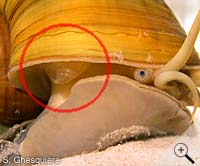 The exhalend siphon at the right side of the head. This siphon is merely a fold of skin instead of a real tube. (Pomacea canaliculata) |
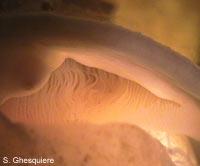 A close up of the ctenidium (gill) in an Asolene (Pomella) megastoma) snail. The thiny filaments, that enlarge the exchange surface considerably, are recognizable. |
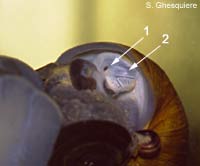 In this apple snail (Asolene (Pomella) megastoma): 1. Pneumostome or lung opening 2. The lung itself. |
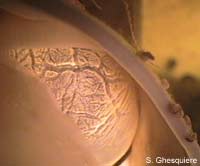 A close up of the lung in an Asolene (Pomella) megastoma) snail. The blood-vessel rich wall is readily visible in the photograph. |
The lung of the apple snail is an air filled sac
in the left mantle cavity.
The walls of this pulmonary sac are very well supplied with blood
to exchange oxygen and carbondioxide (CO2)
between the blood and the air in the lung.
In the picture above, one can see the numberous vessels in the wall of the lung.
The lung can be closed of with a sphincter when the snail is submerged. When
the snail leaves the water, the lung opening (pneumostome or lung aperture)
is held open most of the time to allow a constant airflow in the lung.
Refreshment of the air inside the lung (respiration) when the snail is
under water, is achieved by moving the head in and out the shell, while the
siphon makes contact with the surface. In this way, the lung expands and contracts
to move the air in and out the lung.
The number of body contractions (and thus respirations) varies from 10 to 18
and the duration of each contraction is approximately 1 second.
Take a look at this mpeg movie: [snail_respirate]
(199kb) to see an apple snail (Pomacea canaliculata)
heading to the surface and making contact with the siphon to breathe (The movie
plays at 3 times real time).
| Movies (MPEG1): - Breathing apple snail (Pomacea canaliculata) (199kb, 3x) |
The siphon is an organ consisting of a fold of
the mantle cavity (nuchal lobe) at the left side of the neck above the head
of the snail. When not in use, the siphon is a barely visible, but when needed,
the muscles in this fold contract and the fold changes into a flexible tube-like
structure, which enables the snail to breathe air while staying submerged. The
siphon of an apple snail can thus be compared with a snorkel.
The length of the siphon varies a lot between the different species: all snails
from the family Pomacea have a very long
siphon, when fully stretched it's longer than the snail itself (about 2.5 times),
while the other genera of the family Ampullariidae (Afropomus,
Asolene, Felipponea,
Lanistes, Marisa,
Pila and Saulea)
have shorter siphons (less than the body length).
 Detail of an extented siphon (Pomacea canaliculata). Click on picture to enlarge. |
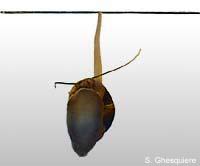 Breathing when submerged (Pomacea canaliculata). |
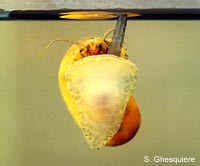 Often overlooked, but Marisa cornuarietis, also has a breathing siphon, although much shorter than in the Pomacea species. |
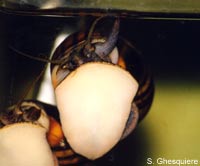 Asolene pixi breathing with its short siphon. |
|
Except where otherwise noted, this page is licensed under a Creative Commons Attribution-NonCommercial-ShareAlike 2.5 License . http://www.applesnail.net |
|